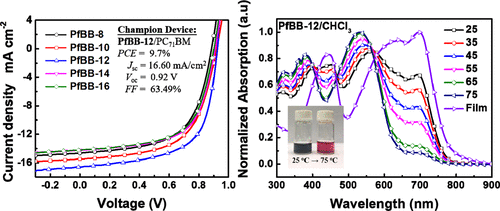当前位置:
X-MOL 学术
›
ACS Appl. Mater. Interfaces
›
论文详情
Our official English website, www.x-mol.net, welcomes your
feedback! (Note: you will need to create a separate account there.)
Benzodithiophene–Dithienylbenzothiadiazole Copolymers for Efficient Polymer Solar Cells: Side-Chain Effect on Photovoltaic Performance
ACS Applied Materials & Interfaces ( IF 8.3 ) Pub Date : 2018-09-13 00:00:00 , DOI: 10.1021/acsami.8b13274 Lanqi Huang 1 , Guangjun Zhang 2 , Kai Zhang 1, 3 , Qiang Peng 2 , Man Shing Wong 1
ACS Applied Materials & Interfaces ( IF 8.3 ) Pub Date : 2018-09-13 00:00:00 , DOI: 10.1021/acsami.8b13274 Lanqi Huang 1 , Guangjun Zhang 2 , Kai Zhang 1, 3 , Qiang Peng 2 , Man Shing Wong 1
Affiliation

|
A new series of low band gap D–A alternating polymers based on 4,5-bis((2-ethylhexyl)oxy)benzo[2,1-b:3,4-b′]dithiophene (BDT) and 5-fluoro-4,7-bis(4-alkylthien-2-yl)benzo[c][1,2,5]thiadiazole bearing different size of lateral alkyl substituents, namely, PfBB-n, n = 8, 10, 12, 14, and 16, was designed and synthesized for high-performance bulk heterojunction (BHJ) polymer solar cells (PSCs). PfBB-n-bearing linear alkyl side chains exhibited strong and controllable aggregation in both solution and solid states, which gives rise to a significant bathochromic shift of the absorption cut-off down to ∼780 nm in thin film. In addition, the strong and wide absorption (350–800 nm) of PfBB-n polymers can compensate for the relatively weak absorption of PC71BM, particularly in the 300–400 range nm to enhance light harvesting of such an active blend. BHJ solar cells based on PfBB-n:PC71BM blends as an active layer showed power conversion efficiency (PCE) in the range 7.8–9.7%. Because of the strong stacking interchain interactions, PfBB-12-based PSC exhibited aggregation-induced spectral broadening, superior structural order, higher exciton dissociation, higher and more balanced charge carrier mobilities, as well as reduced recombination losses. As a result, PfBB-12-based device afforded the best PCE of 9.7%, with the highest short-circuit current density (Jsc) of 16.6 mA cm–2 and open-circuit voltage (Voc) of 0.92 V among devices fabricated. These results demonstrate that the alkyl side chain of the polymer significantly affects the absorption, morphology, and electronic properties of the active blend of PfBB-n/PC71BM, which would provide an alternative useful tool to fine-tune the device performance. Our results also highlight that the electron-rich benzo[2,1-b:3,4-b′]dithiophene building block, BDT, is highly useful for the construction of low band gap D–A polymer for highly efficient PSCs.
中文翻译:

用于高效聚合物太阳能电池的苯并二噻吩-二噻吩基苯并噻二唑共聚物:对光伏性能的侧链效应
基于4,5-双((2-乙基己基)氧基)苯并[2,1- b:3,4- b ']二噻吩(BDT)和5-氟的低带隙D–A交替聚合物的新系列-4,7-双(4-烷基噻吩-2-基)苯并[ c ] [1,2,5]噻二唑带有不同大小的侧烷基取代基,即PfBB- n,n = 8、10、12、14,和16,是为高性能体异质结(BHJ)聚合物太阳能电池(PSC)设计和合成的。PfBB- ñ含线性烷基的侧链在溶液和固态下均显示出强而可控的聚集,这导致薄膜的吸收截止下降至约780 nm时发生了显着的红移。此外,PfBB- n聚合物的强吸收和宽吸收(350-800 nm)可以补偿PC 71 BM相对较弱的吸收,尤其是在300-400 nm范围内,以增强这种活性混合物的光吸收。基于PfBB- n:PC71BM共混物作为活性层的BHJ太阳能电池的功率转换效率(PCE)在7.8-9.7%的范围内。由于强大的堆叠链间相互作用,PfBB-12基于PSC的PSC表现出聚集诱导的光谱展宽,优异的结构序,更高的激子解离,更高和更平衡的电荷载流子迁移率以及减少的重组损失。结果,基于PfBB-12的器件提供了9.7%的最佳PCE,其中器件中的短路电流密度(J sc)最高,为16.6 mA cm –2,开路电压(V oc)为0.92 V捏造的。这些结果表明,聚合物的烷基侧链显着影响PfBB- n活性共混物的吸收,形态和电子性能。/ PC71BM,它将提供另一种有用的工具来微调设备性能。我们的结果还突出表明,富电子的苯并[2,1- b:3,4- b ']二噻吩结构单元BDT对于构建高效PSC的低带隙D–A聚合物非常有用。
更新日期:2018-09-13
中文翻译:

用于高效聚合物太阳能电池的苯并二噻吩-二噻吩基苯并噻二唑共聚物:对光伏性能的侧链效应
基于4,5-双((2-乙基己基)氧基)苯并[2,1- b:3,4- b ']二噻吩(BDT)和5-氟的低带隙D–A交替聚合物的新系列-4,7-双(4-烷基噻吩-2-基)苯并[ c ] [1,2,5]噻二唑带有不同大小的侧烷基取代基,即PfBB- n,n = 8、10、12、14,和16,是为高性能体异质结(BHJ)聚合物太阳能电池(PSC)设计和合成的。PfBB- ñ含线性烷基的侧链在溶液和固态下均显示出强而可控的聚集,这导致薄膜的吸收截止下降至约780 nm时发生了显着的红移。此外,PfBB- n聚合物的强吸收和宽吸收(350-800 nm)可以补偿PC 71 BM相对较弱的吸收,尤其是在300-400 nm范围内,以增强这种活性混合物的光吸收。基于PfBB- n:PC71BM共混物作为活性层的BHJ太阳能电池的功率转换效率(PCE)在7.8-9.7%的范围内。由于强大的堆叠链间相互作用,PfBB-12基于PSC的PSC表现出聚集诱导的光谱展宽,优异的结构序,更高的激子解离,更高和更平衡的电荷载流子迁移率以及减少的重组损失。结果,基于PfBB-12的器件提供了9.7%的最佳PCE,其中器件中的短路电流密度(J sc)最高,为16.6 mA cm –2,开路电压(V oc)为0.92 V捏造的。这些结果表明,聚合物的烷基侧链显着影响PfBB- n活性共混物的吸收,形态和电子性能。/ PC71BM,它将提供另一种有用的工具来微调设备性能。我们的结果还突出表明,富电子的苯并[2,1- b:3,4- b ']二噻吩结构单元BDT对于构建高效PSC的低带隙D–A聚合物非常有用。

































 京公网安备 11010802027423号
京公网安备 11010802027423号